High explosive unexploded ordnance neutralization-Tallboy air bomb case study
2022-03-29RafaMietkiewicz
RafałMie˛tkiewicz
Department of Command and Naval Operations,Chair of Naval Operations,Naval Tasks Unit,Polish Naval Academy of the Heroes of Westerplatte in Gdynia(Poland),′SMIDOWICZA 69,81-127,Gdynia,Poland
Keywords:Low order technique de flagration Hazardous object neutralization Tallboy neutralization UXO neutralization
ABSTRACT On October 13,2020,on the fairway connecting the Polish Baltic ports of′Swinouj′scie and Szczecin,an underwater hazardous object of historical origin in the form of the British deep penetration bomb Tallboy dropped during the bombing of the German cruiser"Lützow"in April 1945 was neutralized successfully.It is believed to be the first underwater action concerning this type of bomb,which has previously been neutralized on land in Europe(Germany,one con firmed case).The preparation of the operation,on an unprecedented scale at national,European and global level,took one year and included a series of projects related to clearing the space around the bomb from other identi fied UXO objects,international consultations,historical analyses,determination of the risk to residents and critical infrastructure in the event of an explosion of the bomb containing approximately 2400 kg of the TORPEX explosive(with an increased force equivalent to almost 3600 kg of TNT).The object was neutralized on spot at the depth of 12 m,near a ferry crossing,by specialists from the 41st Navy EOD Team from the 12th MCM Squadron(8th Coastal Defence Flotilla),using the Low Order De flagration technique(underwater de flagration method).In the case discussed,there was an accumulation of unfavourable conditions which practically excluded the use of blow-in-situ explosive methods(BIP),as well as the extraction of the object and its transport to a military ground.After a partial de flagration of the explosive,the explosive was detonated(DDT).Estimates indicate that the de flagration level reached between 55 and 60%,which signi ficantly reduced the strength and effects of the underwater explosion.
1.Introduction
The bottom of European sea basins abounds in remnants of past military con flicts.Based on assumptions,a signi ficant number of different types of munitions,including chemical weapons(from 360000 to 385000 tons),were dumped in the Baltic Sea[1])as a result of planned activities aimed at the elimination of surplus military assets(all types of ammunition including those for sea,land and air combat),especially after World War II,as an economically effective and relatively fast method of disposing of unnecessary hazards.Taking into account HELCOM’s estimates,there are over 300000 tons of conventional munitions on the seabed,which,unlike chemical munitions,often reside in shallow water.Dumped military ordnance referred to as discarded military materials(DMM)was identi fied as a danger to the general public in the 1980s.Both types of ammunition are often found together[2].
Another element determining the presence of hazardous objects of war origin on the seabed are intense military operations during the First and Second World Wars.The remains of the campaigns played at sea,on land and in the air,in the form of such weapons as:sea mines,torpedoes,air bombs or artillery ammunition,to this day pose a threat to the health and life of sea users(navigation,fishing,offshore industry)and the marine ecosystem.Many of them pose a real threat as unexploded ordnance(UXO).
Hazardous objects lying on the seabed are obviously not only a typically Baltic problem and should be considered a serious challenge by the international community.However,certain European waters(such as the North Sea,the Irish Sea,or the English Channel)are characterised by a certain speci ficity resulting from the nature of the warfare conducted in their areas.For this reason,the seabed of the waters over which the airborne divisions conducted day and night bombardments of Germany during World War II is still covered with air bombs representing different technical conditions.Thousands of allied bombers of all types used overseas flight routes to navigate to targets in Germany.Airplanes often experienced mechanical problems, anti-aircraft fire, German fightersinterceptors or other situations resulting in the inability to drop bombs on the target.As the result,air bombs were often jettisoned over the sea.Despite the procedures to jettison the bombs“safe”,they were often dropped“live”[3].
One of the most frequently presented examples of a tragedy that occurred as a result of contact with a trawled air bomb and subsequent detonation took place aboard the Dutch beamer Maarten Jacob on April 6,2005(three crew members were killed as a result of explosion)[4]).Of the more than 1.600 UXO encountered since the tragedy,approximately 60%were reported to be aerial[3].pp.18).
Also,wrecks of ships and warships fromthe war remain a source of threats from conventional ammunition due to the cargo carried(supplies for both sides of the con flict)and as an element of the military system of weapons during the war.
The Tallboy air bomb was detected underwater in the Piast Canal in the immediate vicinity of the Karsib′or ferry crossing on September 16,2019 by the German company Seaterra,which carried out a bathymetric survey and a subsequent check of ferromagnetic objects using divers.Almost 400 hazardous objects,including a signi ficant amount of artillery ammunition of various types were identi fied as a result of additional surveys within a radius of several hundred meters of the indicated position.In June 2020,as a result of a clearance action near the Tallboy bomb,two objects were neutralized in the form of a British Mark VI mine and a German WBD type deep charge bomb.The area was investigated by the Gavia Autonomous Underwater Vehicle(AUV).The AUV provides solutions for 3D bottom mapping and high-resolution target rendering.As a result of the underwater mission,a sonar image of a dangerous object was provided(Fig.1).
The Piast Canal is a fairway connecting the port of′Swinouj′scie with the port of Szczecin,about 70 km away from the coast,and a specialized port of Police equipped with four handling terminals for bulk cargo such as:phosphorites,apatites,ilmenite ore,potassium salt,fertilizers,ammonia and sulphuric acid.Under the navigation warning introduced by the Maritime Of fice in Szczecin,a hazard zone was introduced around the object and a ban on diving work within a 1000 m radius was imposed[5].
Undoubtedly,the neutralization of such a huge object meant the largest operation of this kind in Poland.As it was previously mentioned,the Tallboy unexploded bombs have been found in the past.One of the most notorious cases was the discovery of a Tallboy bomb at the bottom of the drained reservoir of the Sorpe Dam(Germany)in late 1958.Two bomb disposal experts,Walter Mietzke and James Waters,successfully defused the bomb.The facility was attacked as part of Operation Chastise on the night of 16-17 May 1943[6].Uncon firmed data mentioned two bombs of this type having been neutralized in Germany and an unknown number of bombs-in Norway and France.
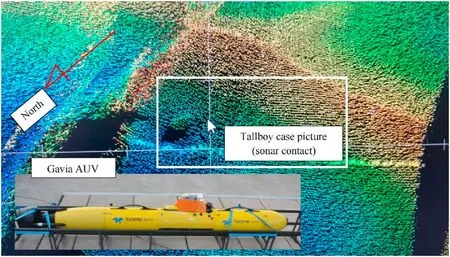
Fig.1.Sonar picture of Tallboy bomb on the Piastowski Canal bottom and Gavia AUV.Source:41st Clearance Diver’s Group(12th MCM Squadron).
1.1.Importance of the′Swinouj′scie-Szczecin seaport complex and the LNG terminal in′Swinouj′scie for the maritime economy
The modernization of the′Swinouj′scie-Szczecin fairway is being carried out in the years 2001-2022 by the Maritime Of fice in Szczecin."Modernization of the′Swinouj′scie-Szczecin Fairway to the Depth of 12.5 m"includes,among other things,deepening of the fairway from the depth of 10-12.5 m over the length of 62 km,with its simultaneous widening from the width of 90-100 m,levelling off the bottom in the area of′Swinouj′scie,as well as widening and deepening of the manoeuvring basins for ships.The project is of key importance for the development of the region and for increasing the availability of Polish seaports.It will enable ships with a maximum draught of up to 11 m(currently 9.15)and almost twice as much cargo to call at the port in Szczecin.Magnetic scanning of the bottom was performed as part of the ferromagnetic reconnaissance conducted for this project.The total volume of the sediment to be extracted as part of the works was estimated at about 23 million m[7]).The ports which are in the area of interest of this paper are responsible for reloading from 30 to 32%of goods,and the increase in their volume indicates a share in the general trend of Polish ports.
The meaning of this region is also evidenced by the location of the only Liqui fied Natural Gas Terminal(LNG)of this scale on the Baltic Sea in′Swinouj′scie.Maintaining the intended level of security of maritime communication lines leading to′Swinouj′scie is of particular importance in the process of maintaining security of energy supply.Poland,as a country importing signi ficant amounts of oil and gas(natural gas)by sea,makes special efforts to monitor the condition of fairways in areas of operation of facilities critical to energy security.One of the main facilities of this type is the aforementioned President Lech Kaczy′nski LNG terminal,whose current processing capacity allows the importing and storing of 5-7.5 billion mof gas per year(prospect of expansion to 10 billion m).It is a key investment in the implementation of the project of diversi fication of natural gas supplies from the Russian Federation,especially in the perspective of the end of the long-term Yamal contract(2021),as well as the growing demand for this resource(in 2017,it exceeded the level of 17.1 billion ma year predicted for 2020).Two cryogenic tanks for process LNG storage with the capacity of 160,000 meach[8]have been built at the terminal,and work is underway to build a third tank with the capacity of 180,000 mof gas.From the moment the terminal was launched in 2016 until July 2020,the port received 100 LNG tankers[10]).It was the immediate vicinity of the strategic facility that determined the planning process of neutralization of a hazardous facility carrying a signi ficant amount of explosives.The drafting of the action plan and necessary preparations took over a year.
1.2.Hazardous objects of historical origin in the′Swinouj′scie area
The origin of hazardous objects located on the seabed in the′Swinouj′scie area is determined by:
·The remnants of World War I operations(especially the 210 mm calibre artillery ammunition on the German artillery batteries of the′Swinouj′scie Fortress forts)[11],
·The fact that the Kriegsmarine naval base,expanded to the size of the largest war port in the Baltic Sea,operated between 1935 and 1945.The warfare carried out during the Second World War(rolling front,allied bombardments of the region and laying mine fields by the fighting sides).With the unfavourable developments on the eastern front for Nazi Germany,the importance of the Baltic Sea for Germany grew in terms of the transportation of troops,evacuation of people from areas threatened by war(East Prussia,Pomerania),and supplies of raw materials from Sweden.As an element of preventing access to sea ports and the future use of the port infrastructure by the enemy,the Germans began to destroy the ports along with their facilities and to mine port basins and approach tracks.A total area of about 460 NMwas mined by all parts of con flict.Based on historical materials,a total of 2726 sea mines(747 contact mines and 1979 non-contact mines)were laid on the waters within the Polish jurisdiction.Of the 1444 bottom mines located in this number,some were equipped with self-liquidating devices onboard[12].Aircraft bombs that are remnants of the bombardments of′Swinouj′scie are a frequent find.Only during one raid carried out by the 8th United States Air Fleet on March 12,1945,1609 tons of bombs were dropped on the city,
·The stationing of Soviet and then Russian troops from 1945 to October 22,1992,
·The existence of naval bases of the Polish Navy since the end of World War II.
In the course of routine seabed surveys,dredging of fairways and canals,repairs of quays or preparation for hydrotechnical works as part of large structural investments,many hazardous objects of war origin are found on the seabed.These include pressure containers used for storing chemical substances and signi ficant quantities of ammunition sunk by the Germans in the last phase of the war.Examples of the objects are presented in Fig.2.In the course of earlier dredging works,constituting an element of the modernization of the fairway,e.g.the British Mark IV air sea mine,the German DM(deep charge)bomb or the British Mark VI mine were found.
During the implementation of the LNG terminal construction project in the newly constructed so-called External Port,it was necessary to carry out works aimed at finding and neutralizing hazardous objects lying at the bottom of the basin.In total,nearly 2000 hazardous objects were neutralized,1406 of which were artillery missile detonators.During the two years of the operation,143 objects were neutralized in 2010 and,respectively,1263 objects a year later[11].The objects neutralized included German and British sea mines and American air bombs(remnants of Allied air operations in the final period of World War II)(Fig.3).
A cursory analysis of the material indicates that in order to neutralize this type of objects it is necessary to know the construction and operation of marine,air and land armaments that were used by the Allies as well as Nazi Germany.This requires building detailed and extensive databases on hazardous objects of historical origin.This is,in a way,a characteristic feature of conducting neutralization activities in the Baltic Sea areas.
1.3.Neutralization of hazardous objects
The primary method of neutralization of hazardous objects covered by the area of interest of this study in the Polish Navy is the explosive method.An explosion is a sudden change in the equilibrium state of a system.The following three types of explosion can be distinguished,which are:detonation,normal explosion and de flagration.Detonation by the phenomenon of decomposition of explosive particles at a speed of 1000-8500 m/s and even more.At present,explosives with a reaction speed greater than 8500 m/s are known[13].It leads to short-term but strong gas pressures which,when expanding,crumble the surrounding environment.The characteristic element is the presence of a detonation wave(vibrations of air and earth)and a very loud bang.An explosion(normal explosion)consists in a rapid(usually 400-1000 m/s)combustion of a flammable substance in an explosive mixture with the participation of oxygen contained in another component of the explosive.An accompanying phenomenon is a bang.Finally,de flagration,which can be compared to very fast combustion,is the non-uniform and rather slow non-uniformity of a potentially explosive reaction.Its speed varies from several to several dozen m/s.The phenomenon may be accompanied by a whistle or a hiss.In speci fic energetic materials de flagration can develop to detonation(De flagration to Detonation Transfer-DDT)[14].
UXO the removal of which to a safe-to-detonate area causes danger for military personnel could be countercharged,blow-inplace(BIP)or‘blow-in-situ’.Solution based on traditional remining techniques could cause severe environmental annihilation at a signi ficant distance fromthe detonation source.Concomitantly,risk to marine biota has to be balanced against the public safety(also critical infrastructure has to be considered).Which is noteworthy,conventional munitions contain a number of various toxic substances namely heavy metals,trinitrotoluene(TNT3)or hexanitrodiphenylamine(HND).The main advantage of low-order techniques for underwater UXO neutralization is reducing the blast effect potentially by 90% compared to traditional explosive methods[15].
Alford Technologies Ltd have developed a range of Low Order De flagration explosive tools designed for use in the marine environment.De flagration sets have now been used for over 15 years in military applications by seventeen Navies(also NATO countries).It is noteworthy that the technique delivers unprecedented levels of protection to the marine environment during future UXO disposal operations.A Low Order of an UXO results in less energy being released into the marine environment than a High Order of the same UXO.Based on Alford information,the explosive content of the UXO,the explosive charge used to High Order the UXO can be more than 600 times larger than the charge used to achieve a Low Order De flagration of the UXO.
In the case of Polish sea areas,EODTeams often take measures to neutralize objects in the form of sea mines and torpedoes with a mass of explosives in the order of several hundred kilograms(e.g.a heavy German G7E torpedo,depending on the version,containing about 245 kg of Hexanite,or a German GC-2 LMB/S bottom mine with 697 kg of the Hexanite explosive).In these cases,substantial damage caused to the seabed(potentially to sea floor infrastructure such as cables and pipes),flora and fauna also must be taken into account.A fatal injury,permanent auditory damage and disruption of normal behaviour potentially resulting in stranding of marine mammals could be indicated as a potential hazardous effects of an underwater explosion for marine creatures,particularly mammals.
In conclusion,the Low Order is used in EOD operations where a detonation is deemed undesirable or unacceptable.It should be noted that the reaction of UXO to Low Order De flagration is different underwater to that conducted on land.The technique requires training and a high level of personnel specialization.The Low Order approach is generally viewed as the most likely way to achieve the best results(safe).However,the worst outcome namely High Order detonation should be always considered.It could be recommended to at last attempt the Low Order first in order to minimize the High Order detonation damages[16]).
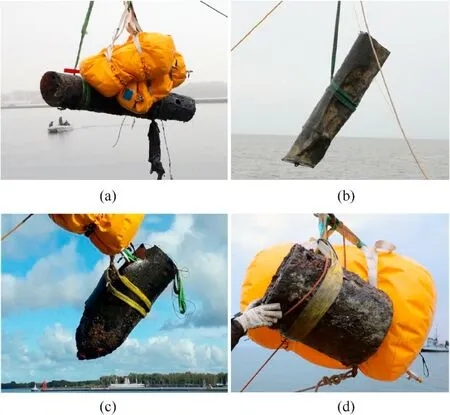
Fig.2.Selected hazardous objects neutralized in the′Swinouj′scie area:a)sea mine Mark VI,b)sea mine Mark IV,c)US AN-M65 aerial bomb-after de flagration-on the background of the ferry crossing,d)German deep charge.Source:41st Navy EOD Team(12th MCM Squadron).
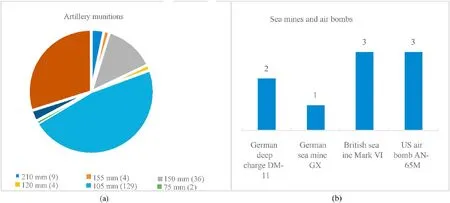
Fig.3.List of major dangerous and explosive objects recovered in the gas port area in 2010-2011(construction phase).a)artillery munitions b)sea mines and air bombs.Source:Own study,based on:[11].
The de flagration method has been used in the Polish Navy since 2013.During this time,neutralization actions were carried out against hazardous objects of war origin lying at the bottom of port areas(′Swinouj′scie,Gdynia,Gda′nsk)as well as Pomeranian Bay and Gulf of Gda′nsk.The operations were carried out by EODTeams,part of the 12th and 13th MCM Squadron of the 8th Defence Flotilla(′Swinouj′scie).The list of selected objects neutralized in the years 2019/2020,which make up the 41st Navy EDO Teams,is presented in Table 1.

Table 1 Selected hazardous objects neutralized by the 12th and 13th MCM Squadrons’EOD Teams in the area of the′Swinouj′scie-Szczecin fairway in 2019 and 2020.
For the first time,the 12th MCM Squadron miners effectively used this method against the WB type deep charge(depth bomb)in 2013.Also,mine divers from the 13th MCM Squadron and representatives of Alford Technologies Ltd.and IBCOL took part in the activities.In the initial period,the unexploded explosives were de flagrated on land-based training grounds.The procedures provide for neutralization of the object on the training ground after extraction and transport to the place of destruction or neutralized directly on the detection position.The second variant is preceded by an analysis of the external situation,which takes into account the vicinity of human settlements,critical infrastructure objects,ecological issues(protected areas).However,initially the decisive factor is the issues resulting from the security of personnel in contact with a speci fic type of hazardous object,such as the possibility of the presence of devices protecting against the extraction of weapons.
In the case of neutralization of armaments,it is necessary to know the construction of speci fic types of sea mines or air bombs,as well as the technical solutions used in the construction of detonators or devices protecting against extraction or defusing attempts.For example,Mark IV mines were equipped with chronometric and hydrostatic safety devices,allowing for safe air transport and airdrop from the plane,but not for protection against extraction(Fig.4).The mine consisted of a body made of sheet metal and two basic functional elements:the explosive compartment and the container containing the apparatus(ignition device,water pressure sensor).In some versions of the mine,the carrier of the explosive charge could be closed by an inclined faceplate.The object was neutralized by means of an underwater charge the energy of which was directed to break through the body of the mine and initiate the process of de flagration of the explosive charge.
Analysing the effects of the applied de flagration method on the presented example,we can see that the following was obtained:firstly,burning out of signi ficant part of the explosive charge.Secondly,the compartment containing the dangerous(explosive)material was torn,which allowed the physical removal of the de flagration residue.Thirdly,the compartment with detonators was separated from the rest of the mine body.This reduced the risk of further object neutralization activities.The threat from the sea mine as a combat system was minimized by practically depriving it of uniform combat features.
The hitherto effects of de flagration of explosives found in historic hazardous objects lying on the seabed have reached the value of several dozen percent.After Low Order Technique has partially burned out the explosives,the explosives’remainder is extracted by the EODteam and detonated on land.The Low Order Technique was successfully used to neutralize air bombs(Type AN-M65)and sea mines(British sea mine,type Mark VI and German sea mines,type GC or deep charges)-on land.De flagration’s method’s effectiveness concerning the American aerial bomb was estimated at ca.40%of the explosive weight used to carry the object.The de flagration of the British Mark VI sea mine’s explosive charge achieved an effectiveness of nearly 80%burnout.Due to the immediate proximity to the Tallboy bomb(only 90 m away),this mine was first hauled away at a distance that made it impossible to transfer the explosion to a larger object[17,18].This case is an example of achieving a high de flagration level without transmitting to detonation.The result of a de flagration always remains an unknown.We deal with dangerous objects that have lain on the seabed for decades during this time of operation.As a result,the explosives’properties with which the ammunition is loaded may change(long-term chemical processes of the explosive contained in the bomb could detonate due to impact,vibration,or pressure variation even with damaged fuses)(8th Coastal Defence Flotilla).In one of the cases of neutralization of a historical object in the form of the German GC sea mine(a ground mine with approx.1000 kg of TNT equivalent onboard),the phenomenon of transfer from de flagration to detonation occurred(DDT).In the first phase of neutralization,which took place in September 2020,the mine was lifted from the seabed to a height of 2 m above the seabed.Later,it was hauled out of the flooding area(the Gdynia port area)and placed at a safe distance from the shore,but at a similar depth(Table 1,line 3).
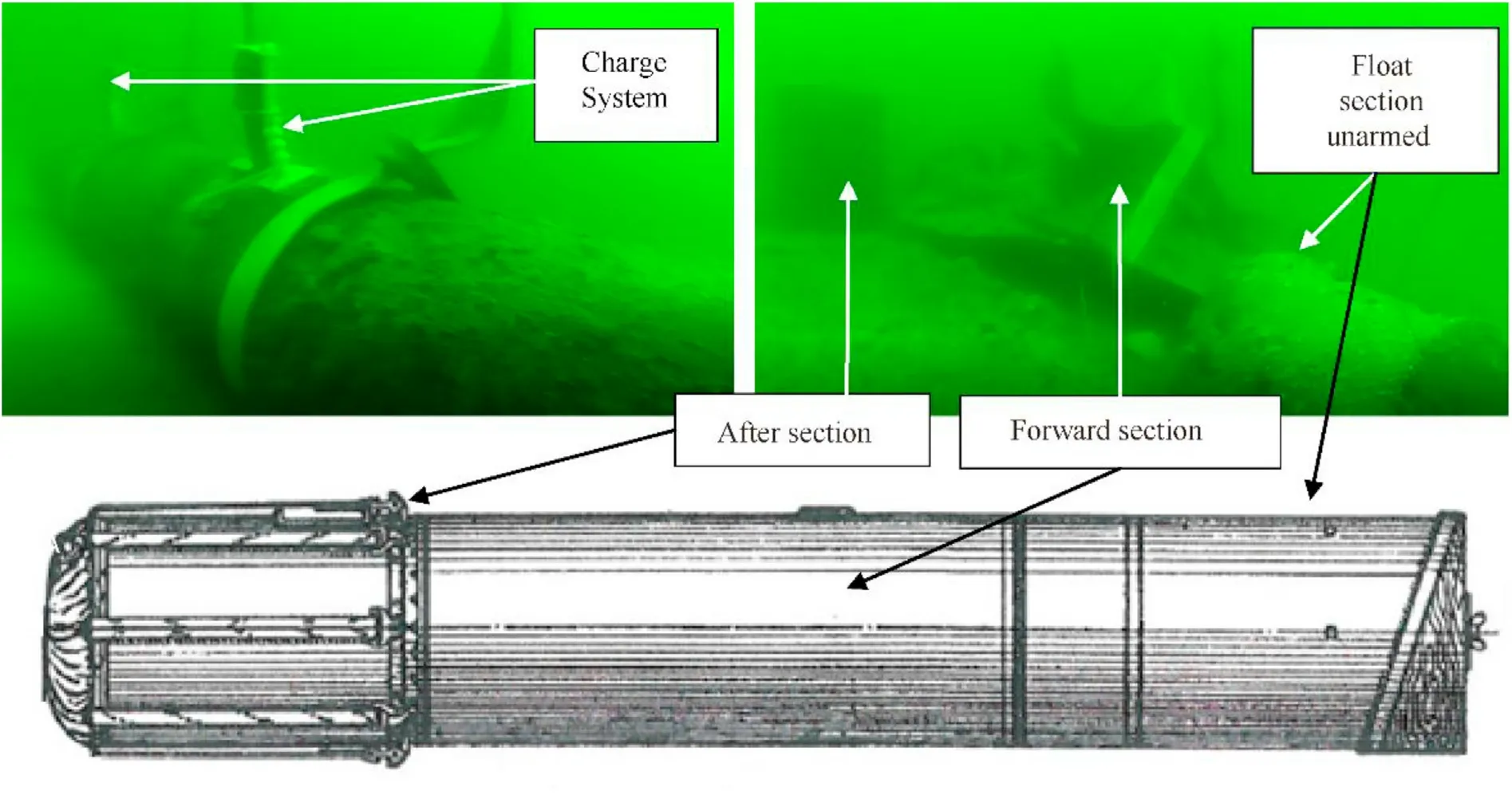
Fig.4.Mark IV British(ELM)sea mine a)before with Low Order Technique Charge System visible ready for use and b)after the de flagration process c)technical view with parachute tube.Source.Task documentation,41st Navy EOD Team(12th MCM Squadron).
The aim of this study is to present the course of preparations and conducting the operation of neutralization of a hazardous objectof gauge and weight of the explosive charge that are unparalleled in this part of Europe-using the de flagration method.While the Low Order Technique is quite commonly used on land to neutralize threats from explosive objects,it is much less frequently used in the marine environment.This is due to the required high level of professionalism of the operators,as well as the cost of acquiring new equipment.The author’s intention was to pay special attention to the use of the de flagration technique in neutralizing the object in the form of the British Tallboy bomb,in a situation of accumulation of adverse factors particularly unfavourable to the use of other methods.First of all,we are dealing here with a huge bomb weight and volume of explosives.Secondly,the reasons for the failure to explode were unknown.Another critical element was the immediate vicinity of the city,together with the port infrastructure and the LNG terminal.These factors made it impossible to extract and transport the object to the blast area.The research therefore took the form of a case study related to the neutralization of the Tallboy air bomb.
2.Material and methods
The study area included the′Swinouj′scie-Szczecin fairway and the Pomeranian Bay,as well as the Gulf of Gdansk,as the main areas of detection,classi fication,identi fication and neutralization of hazardous objects on the seabed of the indicated tanks.
As part of the research,a wide range of historical materials were searched in the form of RAF air reports,footage of the 617th Squadron Dambusters bombings and publications by local researchers of the region’s history,aimed at determining the origin of the Tallboy bomb located at the Karsib′or ferry crossing.Moreover,the 41st Navy EOD Team reports from the 12th MCM Squadron of the 8th Defence Flotilla(′Swinouj′scie)were collected and analysed.Information obtained from the main authors of the concept,and at the same time commanders who lead the course of the complicated operation,namely:Lieutenant Piotr Nowak and Warrant Of ficer MichałJodłoski,was of unique value.The consultations carried out at each stage of the research made it possible to confront the theoretical knowledge,which is the result of a search of literature with results of underwater works.Necessary specialist consultations conducted with the aforementioned experts with long and rich experience(counted in thousands of kilograms of neutralized hazardous objects)made it possible to fill the case study method with rich first-hand source material.
Neutralization of one of the most demanding and challenging for the marine forces,and historically the largest hazardous object in the history of Poland,in the form of the Tallboy bomb,required a non-standard approach to the problem.For the preparation of the EOD Team,a workshop/training took place,which was attended by a representative of the maritime EOD system manufacturer and members of EOD Team.The aim of the training was to discuss the aspects related to the implementation of such a demanding operation using a new technique in the form of 80 mm Magma Charge with a 108Mg Projectile.Manufacturer’s materials provided by Alford Technologies Ltd were a necessary contribution to the methodological aspect.Thanks to the courtesy of the consultants mentioned above,the results of tests on shrapnel of other Tallboy bombs were also made available,and their aim was to select the appropriate neutralization technique.The research was complemented by the analysis of sonar images made during the underwater mission of the Gavia type Autonomous Underwater Vehicle(also made available by the 41st Navy EOD Team specialists),as well as the veri fication of information obtained from the Maritime Of fice in Szczecin.The statistical data concerning turnover in the Szczecin-Police-′Swinouj′scie seaport team was used to indicate their role in the exchange of goods on the Polish Baltic coast.
3.Theory
The Tallboy deep penetration(DP)air bomb was designed by the British aeronautical engineer Barnes Wallis and it was used against Nazi-controlled objects using underground shocks.The bomb body was manufactured of cast steel,with a solid nose plug,and with three exploders fitted 120apart in the base plate.The special tail unit was constructed of light alloy.It was intended to produce heavy shock waves as a result of the main charge explosion deep in the ground.The bomb was carried on specially adapted Lancaster aircraft and was designed to be dropped from 40,000 ft[19].General description of the bomb was presented in Table 2.

Table 2 Deep Penetration(DP),12,000-lb.Mk I,Tallboy bomb general description.
Tallboy dropped from a height of 20,000 feet,was able to penetrate a 16-foot thick reinforced concrete ceiling or create a 100-foot(across craters)and 80-foot deep crater.The optimal height for Tallboy bombing was 18,000 ft.The bomb drop time at 750 miles per hour was 37 s[20]).It is justi fied to discuss the speci fics of the devices on board the unexploded Tallboy bomb being No.47(chemical long-delay type)and No.47A and No.58 Mk I(simple impact mechanism)pistols.It is important to note that in the case of using No.58 Mk I pistol,one had to consider the possibility of failure to trigger when bombing from too low a ceiling.However,it was not possible to determine the minimum height limit for bombing with Tallboy bombs equipped with this detonator.
Taking into account the reports presented,until the Tallboy bomb was identi fied at the bottom of the canal in the vicinity of the Karsib′or crossing,it was believed that all the bombs used in the April 1945 attack exploded.It is worthwhile to stop for a moment to see the course of the operation.The course of the air raid was in fluenced by the effective fire of anti-aircraft artillery,which forced the commander to change his original plans to attack in 3 waves(3 rows-squadrons).Instead,it was planned that a simultaneous attack would be carried out using all machines.Not all Lancasters took their designated positions in the group(the ceiling presented in the table above).They also did not manage to drop all bombs on the first approach.It was not possible to achieve the assumed effect of the so-called turned turtle,as was the case with the attack on"Tirpitz"in Norwegian fjords[21].
The analysis of the ceiling from which the bombs were dropped indicates that it was lower than the previously indicated optimal ceiling of 18,000 feet.The Tallboy bombs with the lowest crewregistered ceiling were dropped from a height of 13,200 feet-2 bombs(Lancaster 1.PD.128 and Lancaster 1.PB.997)and 13,000 feet-1 bomb(Lancaster 1.PB.996).On the other hand,however,analysis of the bombings against the Bismarck-class German battleship"Tirpitz"stationed in the Norwegian fjords provides data that during the Tallboy bombing on October 28,1944,Lancasters from the 617th Squadron dropped bombs from a ceiling of 12,600 ft(minimum reported)to 16,000 ft.Due to the conditions during the action,many crews reported"results unobserved".The ceiling reported during the next expedition against the“Tirpitz”,which determined the fate of the ship,ranged from 12,650 ft to 16,000 ft[22].In light of the above,the hypothesis that the bomb was dropped from the ceiling lower than required by the procedures was not fully con firmed.
The place where"Lützow"was stationed during the raid coincided with the modern location of the ferry crossing in Karsib′or.The historical location of the target of the Allied bombing in April 1945,in relation to the contemporary state of the Piast Canal is shown in Fig.5.The crossing,especially during the holiday season(′Swinouj′scie is a well-known Polish and German tourist destination and holiday resort),handles car traf fic of great intensity.
In addition to the studies of the aforementioned reports of the 617th Squadron bombings,the historical research also included an analysis of film documentation originally made during the American air raid in April 1945 and then edited into film chronicles.As a result,it was possible to observe that one of the bombs(most likely of the Tallboy type),judging by the splash of water on the penetration of its surface,did not explode.Assessing the fall distance,taking into account the knowledge of the cruiser’s structural elements(length of 186 m and width of 21.6),it was estimated that the bomb fell about 50 m from the left side of the ship at the height of the bow tower of the main artillery cal.280 mm.The distance from the wharf to the bomb drop position is about 80 m according to similar estimates.
4.Results and discussion
Based on the analysis of the collected material,it was assumed that in the worst scenario,any movement of the bomb could trigger the pistols.The main task of the EOD specialists was to separate the pistols from the main explosive.Their extraction would allow the bomb to be safely raised to the surface and neutralized on a military training ground.De flagration of an explosive charge remained a secondary issue.For this reason,the selection of an appropriate cumulative insert responsible for the penetrated bomb shells was of key importance.Originally,specialists of the 41st Navy EODTeam considered the possibility of using the Pluton 65 mm shaped charge system using a 108Magnesium Projectile with 250 g of explosive load.As a result of the tests carried out on the body of the Tallboy bomb shrapnel,full penetration was not achieved.On the basis of reconnaissance and materials collected at the Tallboy bomb site,as well as technical information supplied by Alford Technologies and IBCOL,as well as the UK EOD Technical Information Centre(UK EODTIC),the following condition of the hazardous object was established:
·The Tallboy bomb was partially buried with nose-up at an angle of 20-30from the horizontal position,approximately 40%of the bomb was visible(Fig.6),
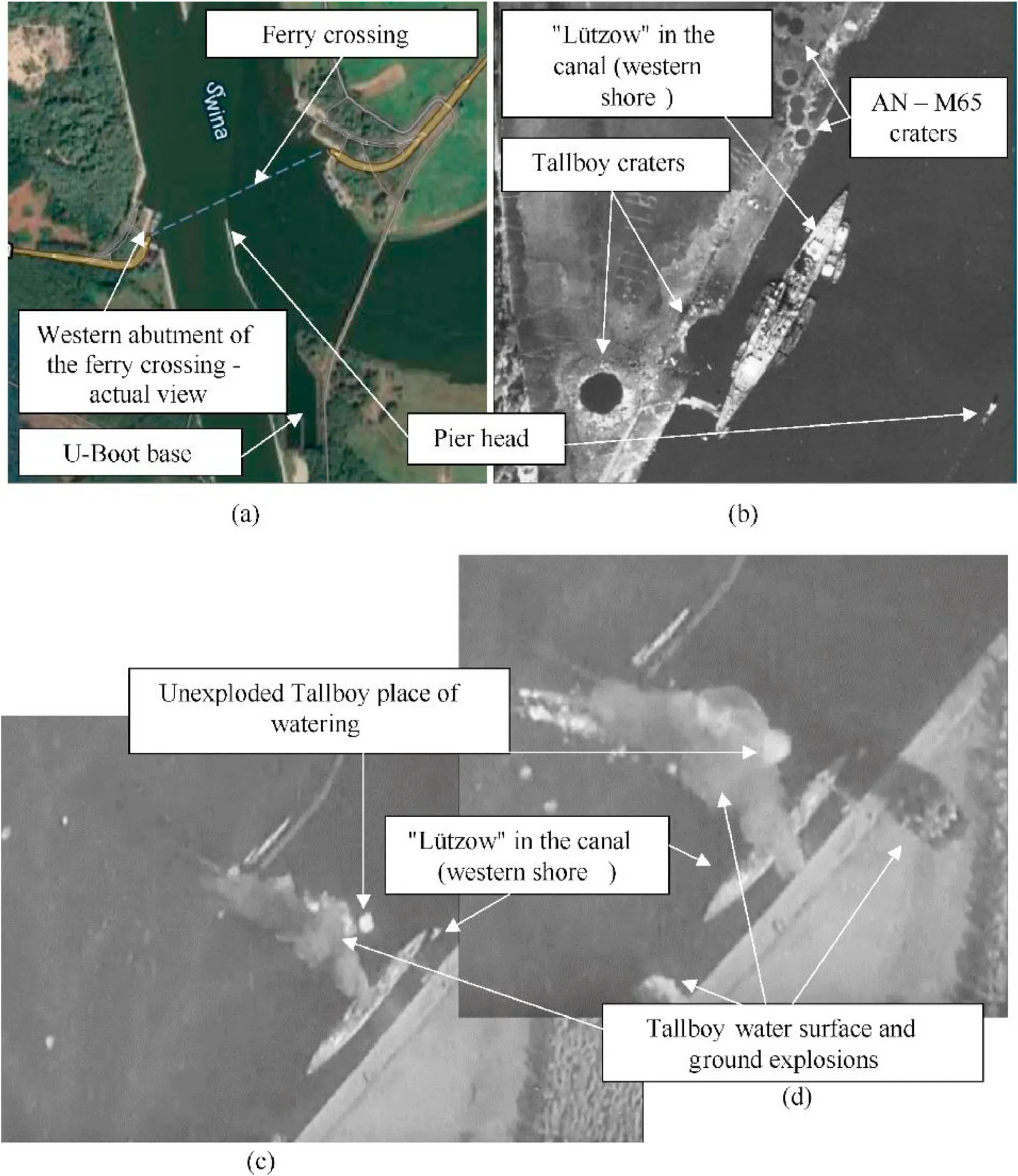
Fig.5.Piast Canal a)contemporary view,b)April 1945 view,c)and d)place where one of the Tallboy bombs fell-without explosion.Source:Own elaboration based on public domain documentation[9].
·The closest canal bottom was compacted sand and clay,
·The condition of the visible parts of objects was classi fied as good,with no evidence nor indications suggesting that the bomb has been moved or disturbed since the moment it was originally dropped,
·The condition of the buried part of the object remains unknown,however it was generally assumed that the bomb was intact.Similarly,the condition or presence of the bomb tail section was also unknown.Moreover,the base plate as well as fuses(situated in the buried place)were at a depth of approx.1 m below the bottom and therefore currently inaccessible.The bomb case thickness was 115 mm at the nose tapering to 32 mm toward the base part,
·The bomb investigated was manufactured from either hardened Chrome Molybdenum or Manganese,
·One of the key questions determining the process of safe neutralization of the object remained the type of detonator used in the bomb at the bottom of the Piastowski Canal.Initial research indicated that the bomb in question was mostly fitted with 3 x British Tail Pistol No 58,at 120intervals(based on available historical data),
·It was assumed that a Shaped Charge Attack could over-pressure the back plate and eject the bomb fuses,
·It was noticed that due to the partial object burial,the Optimum Aim Point may be obscured.
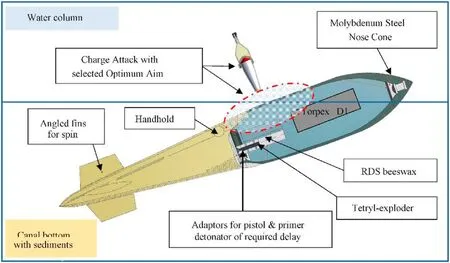
Fig.6.Indicative location of the object at the bottom of the canal.Source:Own elaboration based on the 41ST Navy EOD Team’s reconnaissance outcomes.
Based on details collected,it was assumed that the bomb design,its size,and position in the waterway presented a challenging issue and the safe disposal of Tallboy bomb was a unique EOD task.The Low Order Technique disposal option was discussed as one of the possible scenarios.The main advantages of choosing such a solution included minimizing the risk to life,damage to property and local disruption as well as the fact that it would most likely be the most cost-effective method(Alford Technologies…[25],2020).
Taking into account the previous experience with the use of the de flagration method in the neutralization of dangerous objects(air bomb case penetration with magnesium projectile),two potential scenarios of activities for the Tallboy bomb were presented,namely:
·the first scenario involved the use of the more penetrative 60Magnesium Jet Forming Cone(JFC)in the Pluton Charge System(65 mm Pluton Charge with a 60Mg JFC).Earlier attempts by the Polish Navy EOD divers has established that indicated charge loaded with the 60Magnesium JFC is able to successfully penetrate the Tallboy fragment.
·The second option was related to the use of a large calibre 80 mm Magma Shaped Charge with a 108Mg projectile(80 mm Magma Charge with a 108Mg Projectile).
Preparation for the implementation of the mission with such a high level of risk,taking into account the amount of explosive material,the detonators used and the urbanized area of the operation,required a series of tests with the use of technology on Tallboy bomb fragments(3.2 cm and 3.7 cm of case thickness)from the bombings of the′Swinouj′scie region that the sappers managed to obtain.
When assessing both variants,it is necessary to point out signi ficant differences in the use between the Pluton Charge and the Magma Charge.First of all,due to its higher jet velocity,the 60MG Cone should be considered as having greater penetrating capacity.At the same time,however,the Pluton Charge creates a smaller diameter of penetration hole compared to the 108Cone charge.In summary,the Pluton charge should be considered more aggressive.The charge has been used successfully in the past for Low Order Technique missions,however,in this case,an increase in transition to detonation(DDT)risk should be taken into account.The second option is related to the use of a higher calibre Magma charge with a correspondingly increased explosive load to 500 g maximum.Magma(80 mm Magnesium 108projectile)has the potential to pierce thicker parts of the bomb case.The use of too much charge of explosives could cause a DDT,therefore it was necessary to conduct additional tests on the hull penetration of a Tallboy class bomb(Alford materials,2020).Finally,after failing to obtain penetration of a Tallboy bomb shrapnel using Pluton 108charge,Navy EOD Team specialists,who are also the main consultants of this paper,developed a scenario of action using Magma charge.
In the process of preparation for the Tallboy bomb neutralization operation,much attention was paid to the analysis of the current condition of the object in terms of maintaining the tightness of its body,taking into account the time under water and the following corrosive processes.Taking into account previous research on the condition of hazardous objects lying on the Baltic seabed(mainly:sea mines,torpedoes,depth bombs),it was established that the state of ammunition primarily depends on[23]:
·The material of production and the calibres,
·Way of packing(mainly artillery shells- water-resistant container,tubes),
·Type of button in the area(especially sediment types)[24],
·As well as the corrosive process that affects the hazardous object detection process.
As part of the preparations,in order to take care of the condition of the critical infrastructure(LNG terminal and cryogenic tanks),the risk of transferring the effects of a possible detonation to them was estimated,depending on the course of the de flagration process.At the same time,the least favourable scenario was assumed,involving an immediate move from de flagration into detonation.For the duration of the neutralization action(5 days),the city authorities ordered an evacuation for 750 inhabitants staying in the so-called absolute evacuation zone(2500 m from the fairway axis).The zone of direct danger to life and health was estimated at 2000 m.For residents within the range of the open space zone(500 m outside of the red zone-3000 m),an order was introduced to stay in buildings in places of residence.16,500 m was the danger zone for people submerged in water(sizes based on calculations of 41st Navy EOD Team).For the duration of the operation the gas supply in the LNG terminal was suspended and the gas network was secured.12 seismic sensors were placed in selected points of the city and their indications will be analysed later.
During the first phase,the divers levelled the bottom and uncovered the upper surface of the bomb body.Next,a PVC ring was placed in the axis of the missile,which allowed to expose the place where the detonators were fixed,and at the same time protected the object against sediments and stabilized its position on the bottom.The ring was designed by specialists from the Clearance Divers Team.Civilian divers removed winning from inside the ring and plunged it into the bottom around the back of the bomb.Ejectors were used to remove the bottom sediments,thanks to which a 3-m layer of sand and silt was ef ficiently removed(Fig.7).
The set for using the de flagration method has been prepared and assembled on board the vessel securing the operation and then placed on a sediment-free fragment of the Tallboy bomb in the optimal place for de flagration.The process of rapid combustion(Low Order Technique),was triggered by a cumulative insert penetrating the object body,followed by a chemical reaction with the explosive,under the in fluence of which it underwent a thermodynamic transformation.
The process was initiated by radio and after 6-7 s the transition from de flagration to detonation(DDT)took place.On the basis of measurements of the height of the water column observed(originally about 95 m),which rose above the surface of the canal,as well as the absence of debris in the air space and the intactness of glass structures in objects 100 m away from the position of the object,it was estimated that an explosive of less than 1000 kg(Fig.8)was detonated.The calculations carried out for an underwater explosion with a force corresponding to the original gauge of the explosive that the Tallboy bomb was elaborated with indicated the creation of a 165 m high water column.Taking the above into account,it was estimated that the de flagration ef ficiency reached 55-60%of the explosive burned.The action was successful and the object was neutralized on October 13,2020 at about 2:31 p.m.
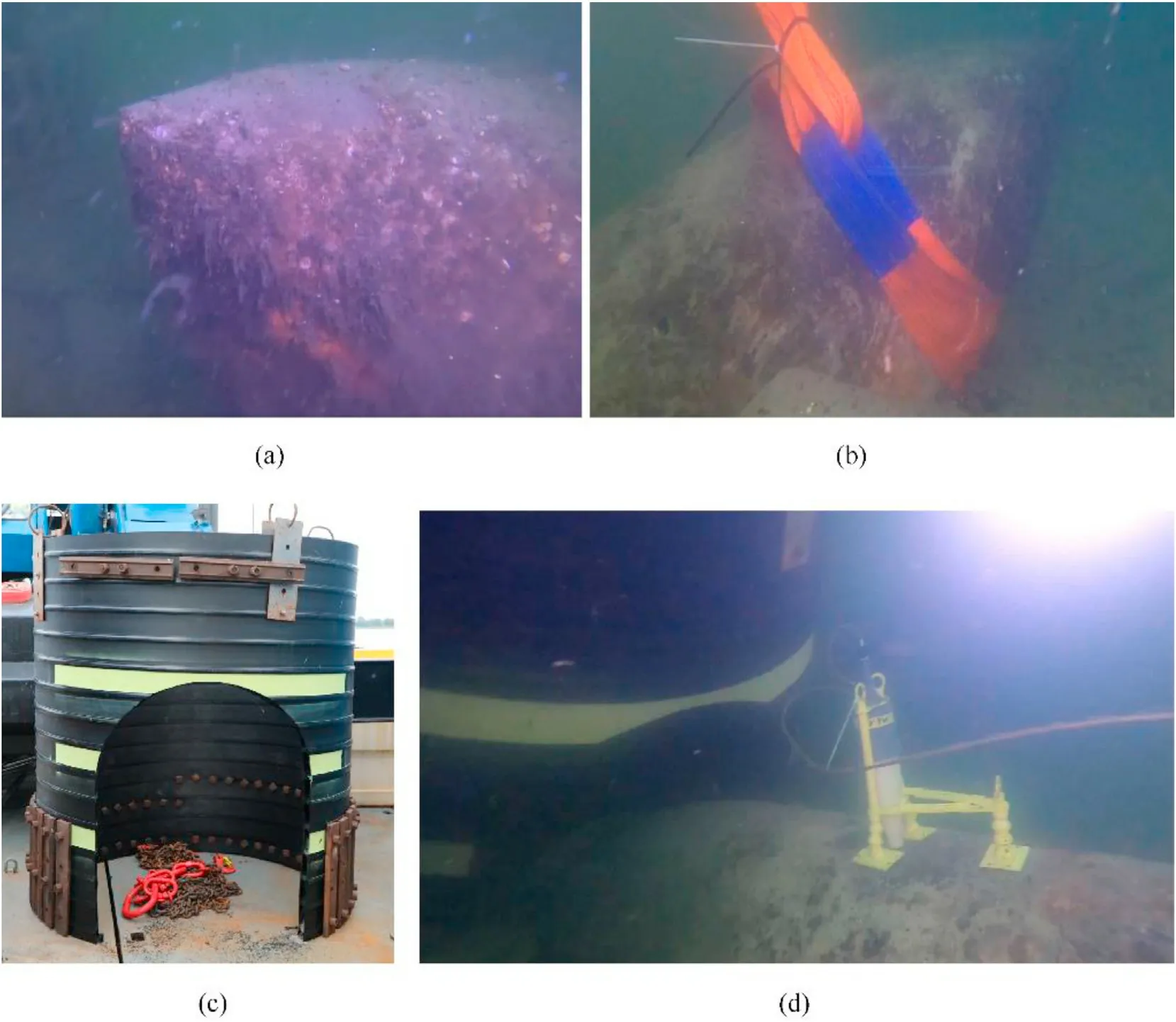
Fig.7.Underwater photographs of the Tallboy bomb in the final stage of preparation for neutralization a)general condition of the bomb’s bow part b)ring surrounding the bomb,c)PVC ring prepared for launching,d)Tallboy with charge before the action.Source:41st Navy EOD Team.
After the operation was completed,a reconnaissance was carried out to neutralize the hazardous object to assess the effects.As a result of the divers’actions,it was found that at the bottom of the reservoir,there are remains of underwater detonation in the form of fragments of various sizes.The course of preparations and the operation itself is still carefully analysed by the armed forces.Due to the unprecedented UXO underwater scale,NATO allies also became interested in the operation’s course.Based on the results of measurements carried out by scientists from the Pozna′n University of Technology,set up a seismic sensor system(a dozen or so seismic sensors,half of which were located 100 m to 1 km from the epicentre.The farthest one was approximately 7 km away from the LNG terminal)around the neutralized object.It was estimated that the effectiveness of the de flagration process reached the level of 37%of the burnout of the initial size of the explosive[18].Thus,it can be assumed that the explosive mass until it passed to detonation was reduced by about 873 kg to the level of 1486 kg.Due to the operation’s course,it was impossible to verify the original assumption,which involved the ejection of part of the bomb with mounted pistols.Without a doubt,however,the calculations regarding the selection of the initiating charge concerning the thickness of the Tallboy bomb’s casing have been con firmed.
5.Conclusions
As a result of the research process conducted,concerning the Polish Navy’s experience with the use of Low Order Technique(de flagration)and case study from the naturalisation of the largest hazardous object in the history of Poland in the form of the English Tallboy bomb,the following conclusions were drawn:
·The Low Order Technique(de flagration)seems to be a suf ficiently effective method for safe neutralization of hazardous objects of war origin(historical ordnance)conducted in a speci fic marine environment.It allows the operations to be carried out directly where the hazardous objects are located,which signi ficantly reduces the costs of operations due to the traditional(explosive)neutralization methods that require physical transport of the objects from the site of their location to the place of detonation(military training grounds).National experience shows that under favourable conditions,the effectiveness of de flagration can reach the level of 80%.
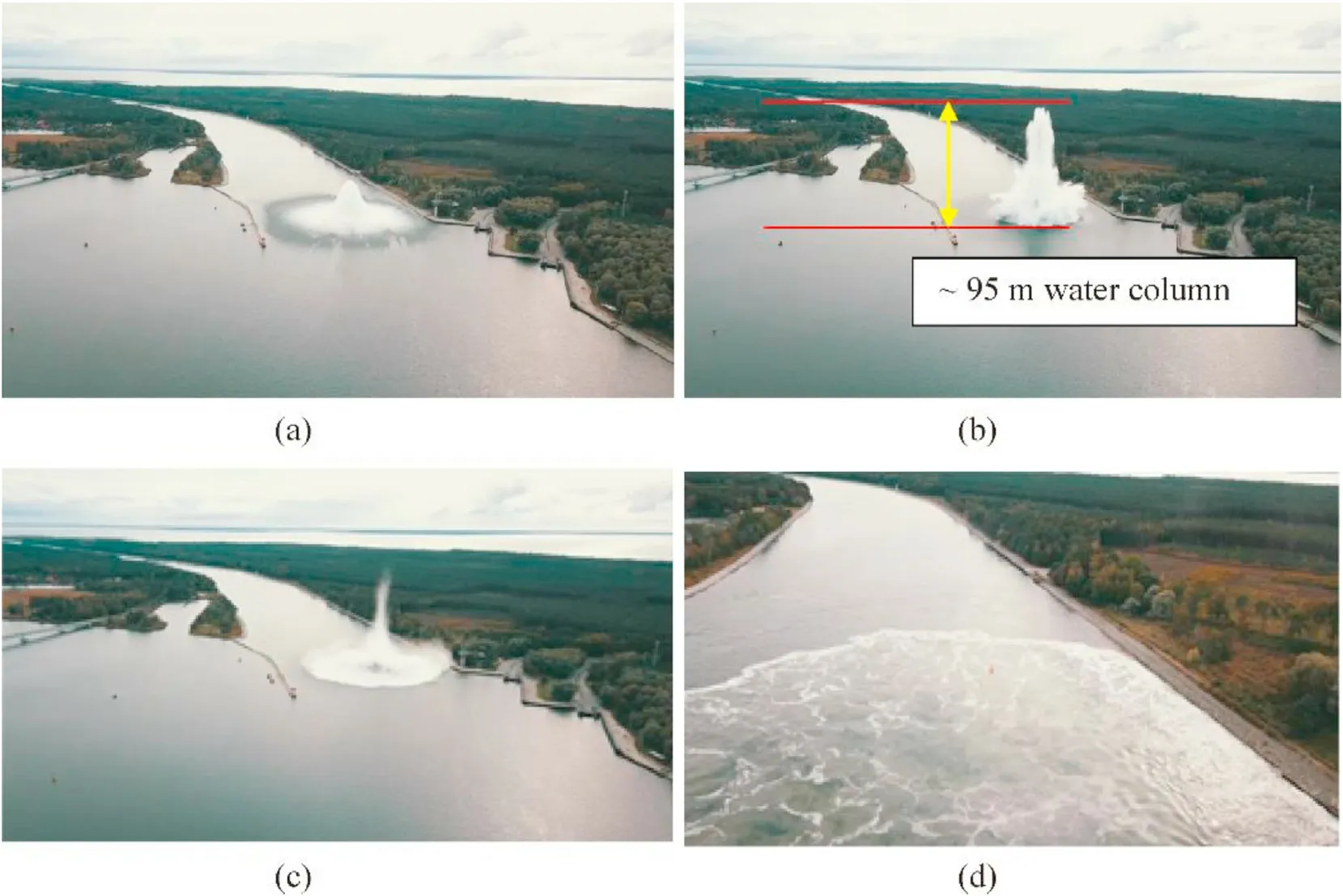
Fig.8.Tallboy explosion stages a)initiation,b)maximum water column,c)d)after water turbulences on the canal surface.Source:Major Piotr Abramowicz(CSWIiCh).
·Even if a small level of burnout is achieved,the method allows effective neutralization of the explosive by opening the object’s casing(sea mine,air bomb)and,with the Charge Attack’s appropriate location,ejecting compartments containing detonators.This means depriving the object of its combat characteristics.The tearing of the object’s casing makes it possible to safely remove the explosive or extract it to the surface(after the detonator compartment has been ejected)without the risk of explosion and subjecting it to further neutralization operations.
·The Low Order Technique can be successfully used to neutralize objects that do not qualify for extraction due to the use of onboard protective devices(especially certain types of sea mines),or if there are dif ficulties in identifying the detonators used.Each time the de flagration method is implemented,one must consider the analysis of objects with particular emphasis on the thickness of the object’s casing.Each time the de flagration method is used,it must consider the study of objects with a speci fic focus on the thickness of the object’s body.The selection of an appropriate tool(charge)to initiate the de flagration process is primarily associated with penetrating the compartment’s hull filled with explosives.In the analysed case,the Tallboy bomb’s hull was in excellent condition(partially buried in bottom sediments),despite having been lying on the bottom of the canal for several decades.
·The undoubted disadvantages of the method include the fact that it cannot be re-used in the event of an unsealing of the body of a dangerous object(e.g.an air bomb or a mine)after an earlier use of de flagration.
·Another element that should be taken into account when using the de flagration method is the possibility of switching to detonation,which was the case in the discussed case.Each second of the Low Order Technique process reduces the mass of the explosive in the hazardous object and thus limits the hazardous zone in the event of transmission for detonation.Thus,the potential adverse effect on the environment(e.g.shock wave,fragmentation)is reduced.
·Carrying out operations to neutralize such dangerous,due to the gauge of the explosive,objects such as the Tallboy bomb,requires the cooperation of specialists from many fields and obtaining knowledge in such areas as underwater operations technique,use of modern technologies(Autonomous Underwater Systems)or historical research of international scope and the application of innovative methods and tools in direct cooperation with the manufacturer.Undoubtedly,at the same time,the exchange of experience between military personnel and manufacturers brings bilateral bene fits in the form,on the one hand,of developing more effective tools and gaining experience from their use,on the other.
·Developing procedures and gaining necessary experience by EODteams will be of key importance in minimizing threats from conventional munitions lying on the seabed in areas of such projects in the Baltic Sea as:construction of offshore wind farms,construction of the Baltic Pipe,construction of the Outer Port in Gdynia or construction of the Floating Storage Regasi fication Unit(FSRU)gas terminal on the Polish coast.
·Despite the passage of more than 7 decades since the end of World War II,a thorough analysis of the documentation related to the course of combat operations may bring new findings.Evidence of this can be the missing indications regarding the Tallboy which did not explode in contact with the canal surface in the reports of the 617th RAF Squadron.
·The reason for the lack of explosion of the April 1945 Tallboy bomb was not explained.
All authors have seen and approved the final version of the manuscript being submitted.They warrant that the article is the authors’original work,has not received prior publication and is not under consideration for publication elsewhere.
The authors declare that they have no known competing financial interests or personal relationships that could have appeared to in fluence the work reported in this paper.
杂志排行
Defence Technology的其它文章
- Dynamics and rebound behavior analysis of flexible tethered satellite system in deployment and station-keeping phases
- Finite element analysis of functionally graded sandwich plates with porosity via a new hyperbolic shear deformation theory
- Investigation on the penetration of jacketed rods with striking velocities of 0.9-3.3 km/s into semi-in finite targets
- The effect of strain rate on compressive behavior and failure mechanism of CMDB propellant
- Adaptive target and jamming recognition for the pulse doppler radar fuze based on a time-frequency joint feature and an online-updated naive bayesian classi fier with minimal risk
- In fluence of metal/composite interface on the damage behavior and energy absorption mechanisms of FMLs against projectile impact
